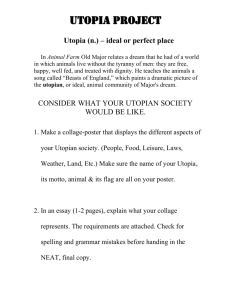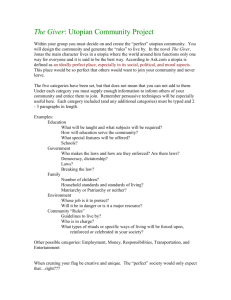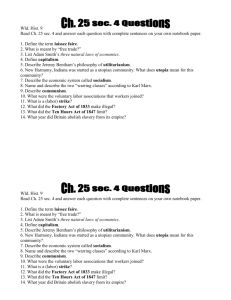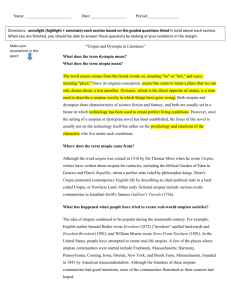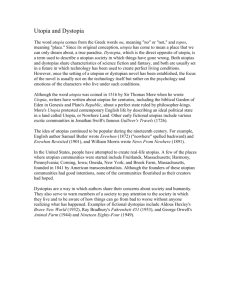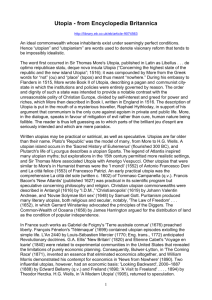Roads to Utopia Interlude: From Renaissance to Victorian Barnita
advertisement
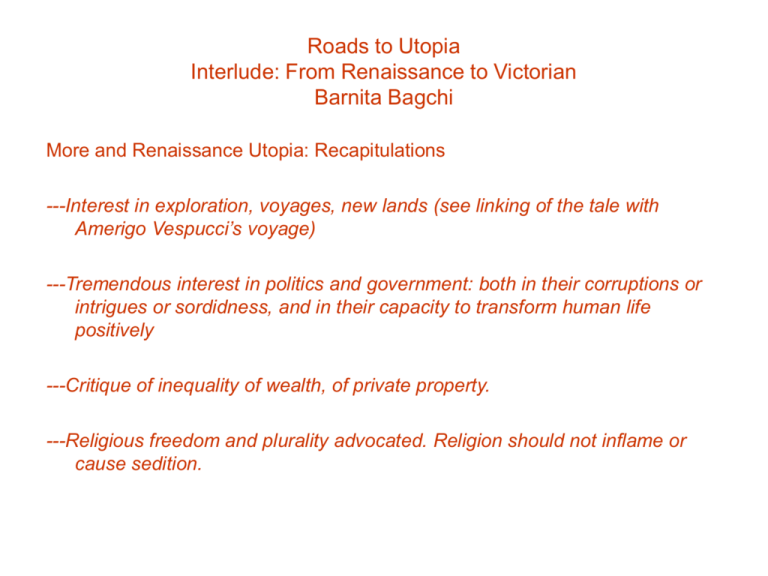
Roads to Utopia Interlude: From Renaissance to Victorian Barnita Bagchi More and Renaissance Utopia: Recapitulations ---Interest in exploration, voyages, new lands (see linking of the tale with Amerigo Vespucci’s voyage) ---Tremendous interest in politics and government: both in their corruptions or intrigues or sordidness, and in their capacity to transform human life positively ---Critique of inequality of wealth, of private property. ---Religious freedom and plurality advocated. Religion should not inflame or cause sedition. More’s Utopia: Recapitulations • Plays with the question of how seriously we could take the work. • Plays with comparisons between contemporary England and Utopia: distorting mirrors? • Human happiness is the goal. • Considers deeply work and leisure. • Love of the expanding boundaries of human knowledge. • Many contradictions: for example, war. • Hierarchical. Other Major Utopian Writing 15001660 • In its own way, Shakespeare’s The Tempest is a utopian/ dystopian play. In post-colonial readings, Prospero is the magician-king-colonizer, Caliban, the colonized, is made to slave for this colonizer. There is a conspiracy involving the ‘baser’ characters in which a vulgarised version of utopia is articulated. Other Major Utopian Writing 15001660 • Tommaso Campanella’s City of the Sun (1623). • Francis Bacon’s New Atlantis (1626) • Campanella’s is a theocratic state where women, goods, and children are held in common. Christian imperialist sub-theme. • In Bacon’s island, the brightest and best are trained in Salomon House in the scientific and experimental method, which Bacon championed. After More • Four main historical stages in evolution of utopian writing (Claeys and Sargent, p. 3) • Religious radicalism in 16th and 17th centuries produce egalitarian schemes, giving importance communal property-holding, from Spartan and Christian points of view. Socialism. English Revolution of the 17th century (beheading of Charles I)—radical sects such as Levellers and Diggers. • Voyages of ‘discovery’ from the 16th century—debates about the virtues and vices of ‘primitive’ peoples. (Shakespeare’s The Tempest—Caliban, the primitive man, for example) • Scientific discovery and technological innovation holding out the promise of a far better (or far worse!) life. Science fiction and its associates as bearers of utopian and dystopian impulse. • French and American Revolutions: aspirations for greater social equality, utopian promise of revolution and new lands. USA, Australia. Small new utopian communities: an explosion of them in the US. Owenite, Fourierist communities in 19th century. Kibbutz. Hippie communities. Squat communities in the Netherlands… We Need to Add Others • • • • Missing from the earlier picture are Women Colonized. Colonized indigenous peoples e.g. Native Americans and Aborigines in Canada, USA, and Australia. • And many other categories, such as sexually marginalised groups. • Women, and the colonized acquired powerful voices, and wrote powerful utopian fiction. E.g. Herland, Sultana’s Dream. Enlightenment Utopia • 1660-1800, broadly speaking, is the period of the European Enlightenment, with its emphasis on reason, science, progress, and order. • Utopian and dystopian writing of this period include Jonathan Swift’s Gulliver’s Travels. • This is satirical. Using races of huge, little and idiotic men (Brobdingnag, Lilliput, Yahoos), Swift savages many aspects of contemporary human society. His ideal a race of rational horses, the Houyhnhnm? Enlightenment Feminist Utopia • Sarah Scott, Millenium Hall (1762), for example. • A group of women banding together in a country-estate, with a common vision of welfare, helping the poor, infirm, and disabled, incomegeneration for such people. • A project led by gentlewomen, who have had to leave their families because of despotic fathers, horrible stepmothers, impossible marriages… • A male voice, a visitor into the community, offers approval. A feature in Herland too. Industrialization and Utopia/ Dystopia • The Industrial Revolution, late eighteenthcentury to late nineteenth-century. Massive transformation in ways people work, produce things. Transformations also in rhythms of life. Transitions from the rural, agrarian-based economies to the worlds of ever-multiplying cities. Industrializing Nineteenth Century Hotbed of Utopianism • This is the period when people try to put into practice utopian communities, when movements that Marx called ‘utopian socialism’ flourish, when people write thoroughly fascinating anti-industrial utopia like News from Nowhere. Romantic Utopia • To understand Morris, a poet such as William Wordsworth, a Romantic poet, is useful. • Wordsworth made the northerly Lake District of England into a real-life utopia through his poems. • Rooted, enduring, rural and pastoral forms of life. Sheep and shepherds, primal dignity and innocence. • In contrast to the huge wealth and huge poverty, the disparities and churning, exploitative chaos of urban industrialization. Shakers, Fourierists, Owenites, Saint-Simonians… • A host of radical socio-political movements such as the three mentioned above try to formulate utopian schemes, communities, houses, and lands. • All have some form of socialistic inclination. • Various kinds of radical sexual experimentation in some cases, such as the Saint-Simonians. • Co-operative production. • Radical Christianity: Shakers. Among their most enduring productions are the wooden furniture they produced. Victorian? • Reign of Queen Victoria in Britain. • 1837-1901 • British Empire at its zenith. • Socialism also flowers, in many different versions. Morris’s utopian socialism, Marx’s scientific socialism. • Marx lives in London during the Victorian period! The Communist Manifesto (1848) is today considered a utopian text par excellence. Feminisms Develop in the period Between 1850 and 1930 • Globally. • In the USA, in India, in Egypt. • Charlotte Perkins Gilman is a journalist, an activist, and a feminist in the USA during this time. Writing in newspapers, periodicals, publishing books pamphlets… • In India/ South Asia, Rokeya Sakhawat Hossain, younger than Gilman, is also a writer in journals and reviews, founder of a school. • Women who craft their own lives, and in a sense attempt to live out utopia. • We have come a long way from More to Morris to Hossain. • Utopian writing as key embodiments of social transformations and change.
